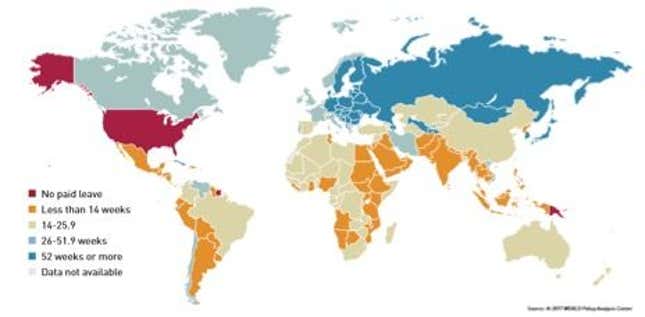The first year of a child’s life is so important not only for the family unit, but also for society. All the data supports this.
Paid parental leave has been linked to higher birth weights and lower rates of infant mortality. Mothers who get paid leave breastfeed more and for longer, which is one of the best ways to protect the health of a newborn. Babies are more likely to receive well-baby medical visits and vaccines. Mothers and fathers form a strong attachment with their child, which is important for successful development for the child and for the long-term emotional health of both parents and children. The list goes on. That is why we have made the first year of life a priority in our programmatic work. This includes the foundation’s Maternal, Newborn & Child Health work to help healthy mothers deliver healthy children and promote resilience among women and children, and the foundation’s new Gender Equality strategy, which focuses on economic empowerment for women and girls through financial and market inclusion.
We needed to be aligned with what we stand for outside and what the experience is like to work here on the inside. Especially when it comes to family leave. Up until 2015, our family leave policy met—or even slightly exceeded—the bar, but it wasn’t a leading-edge program, and we knew we must lead the charge.
Because of our unique circumstance at the foundation, three years ago we could take these opportunities and dream big, asking ourselves: What would parental leave look like if we designed it around a commitment to healthier babies, strong and resilient families, and parents who are able to thrive personally and professionally?
Because of that commitment to our missions and our employees, we established a parental leave program that offers 52 weeks of paid time off for mothers and fathers in the first year of a child’s birth or adoption.

The U.S. is one of the few countries without mandated paid maternity leave (and fewer than half of countries provide paid paternity leave). However, in many organizations, family leave is paying off with an increase in engagement, productivity, and talent retention. For example, when Google extended its paid maternity leave from 12 to 18 weeks, it saw a 50% increase in employee retention among women who had babies. In contrast, insensitivity and lack of “civil organizational behavior”—such as showing little support for new parents—can, according to research by Georgetown University’s McDonough School of Business Professor, Christine Porath, “cause employees to lose focus, be less engaged, and have health problems,” none of which is good for individuals or organizations.
Paid parental leave increasingly is proving to benefit the foundation, too. For example, when one employee steps away to spend time with their growing family, another has the chance to step up or over in their work at the foundation. That person is learning something phenomenal from the chance to backfill for a colleague, and that contributes to his or her career. Many of those employees, who we’re now tracking, have had additional opportunities at the foundation as a result of their backfill contributions. As the leader of our HR team, there’s nothing more rewarding than seeing your workforce take on new challenges, be better for it, and contribute to the foundation’s impact in the world. And that’s exactly what I’ve seen through this 52-week parental leave program.
Although our parental leave program is relatively new, we have learned much. We have worked with managers and employees from a cross-section of teams and roles to orchestrate creative solutions to ensure the most essential work is handled skillfully while parents are on leave. We have listened to diverse voices, addressed a range of needs, and developed a variety of solutions. Some of our lessons learned include:
- Include the right people, early on, every time. In working with specific leave situations, ensure appropriate colleagues are involved early. Different perspectives are needed to define the work, identify what is required of the backfill candidate, and to provide advice on what is possible, given program guidelines. Involving the right people early on also helps in the smooth transition of work when the employee’s leave begins.
- Empower managers and support employees. It’s important to balance empowering, light-touch processes with ensuring managers and colleagues feel supported and accountable to achieve a solution. We found managers wanted guidance on how to hold conversations with employees who are planning to take leave and with those who were interested in backfilling. We created simple materials to help managers prepare for these conversations.
- Create well-defined processes and communication around internal movement. Managers and employees need clear guidance about backfill processes and expectations. The HR teams managing benefits, talent, and recruiting need to coordinate and communicate as one—and provide greater transparency about the internal talent pool across the organization.
At the foundation we have not figured everything out and don’t claim to have all the answers. All new parents have experienced perks and pitfalls, and each experience creates distinct opportunities and challenges around staffing, business planning, and meeting goals. We are working through questions about how to best deploy and develop backfill employees, and, of course, the costs associated with the program.
We know all organizations will have their own unique factors to consider, including the nature of their work and sector; their organizational structure and culture; their talent management systems; and their direct and indirect costs. Our hope is that by sharing our successes and what we are still learning it will allow other organizations to develop and implement tools that work for them, and that closely align with their purpose and values.
Steven Rice is chief human resources officer at the Bill & Melinda Gates Foundation.
